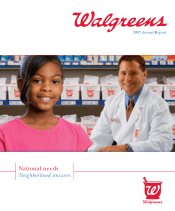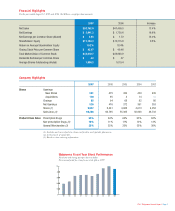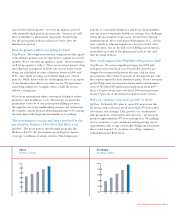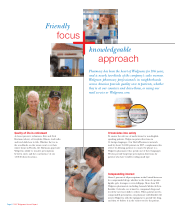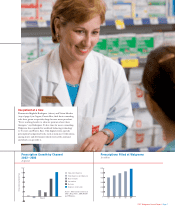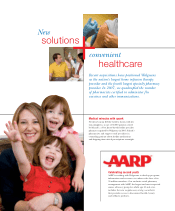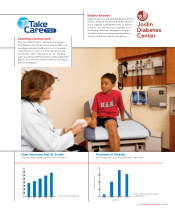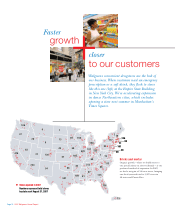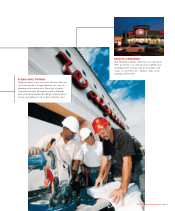Walgreens 2007 Annual Report Download - page 5
Download and view the complete annual report
Please find page 5 of the 2007 Walgreens annual report below. You can navigate through the pages in the report by either clicking on the pages listed below, or by using the keyword search tool below to find specific information within the annual report.
factor in the fourth quarter – we were up against a period
with unusually high generic gross profits. Generics are still
more profitable to pharmacies than name brand drugs,
but the gross profit dollars realized are lower after the
introductory period.
How do generics affect you going forward?
Greg Wasson: The tough year-over-year comparisons with regard
to blockbuster generics can be expected to continue for several
months. We’re currently up against a “peak.” By next summer,
we’ll be up against a “valley.” There are no major generic drug
introductions anticipated in 2008, but several name brand
drugs are scheduled to come off patent between 2009 and
2011, once again creating a potentially high wave of new
generics. While these cycles are challenging, they’re an aspect
of our business that affects our entire sector. We experience
something similar, for example, when a mild flu season
follows a strong one.
We’re in an environment where everyone is looking to reduce
pharmacy and healthcare costs. That means we must take
permanent costs out of our prescription filling processes
through the use of groundbreaking systems and technology.
We consider current projects addressing this issue to be among
the most important long-term investments we’re making.
The government is more and more involved in the
prescription business. How does this affect you?
Jeff Rein: The good news is that through programs like
Medicare Part D, the government provides prescription
coverage to millions of senior citizens. This brings more
patients to convenient drugstores and keeps them healthier…
and out of more expensive healthcare settings. Our challenge
is that the government is also more involved in reducing
reimbursement. We’re working in Washington, D.C., and in
state capitals to educate legislators – not just on the value
of medication, but on the full cost of filling a prescription,
particularly in terms of the pharmacist’s role in safe and
effective drug delivery.
How much impact have Wal-Mart’s $4 generics had?
Greg Wasson: We saw no significant impact in 2007 and
anticipate none this fiscal year. Four-dollar generics are
designed for uninsured patients who pay cash for their
prescriptions. More than 95 percent of our patients pay only
the co-pay required by their insurance plans. These customers
prefer Walgreens convenient locations and broad pharmacy
services. We filled 583 million prescriptions in fiscal 2007 –
that’s a 10 percent increase over fiscal 2006 and represents
nearly 17 percent of all retail prescriptions in the nation.
Will you continue your store growth in 2008?
Jeff Rein: Definitely. We plan to open 550 new stores this
fiscal year, with a net increase of more than 475 stores after
relocations and closings. That growth – in combination
with promotions, retirements and turnover – means we’ll
promote approximately 875 store managers in ’08, making
us very attractive to job candidates seeking strong career
opportunities with a respected retailer. Walgreens is currently
the second largest U.S. recruiter on college campuses,
behind Enterprise Rent-A-Car.
2007 Walgreens Annual Report Page 3
Sales
In billions of dollars
Earnings
In millions of dollars

